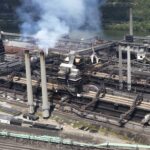A giant steam-filled tank weighing nearly 2,000 pounds that exploded at a St. Louis, Mo., box plant, flew a quarter-mile into the air and smashed into a neighboring building, was being used despite needing emergency repairs, federal investigators said.
The April 3 explosion at Loy-Lange Box Co. left four people dead. The blast propelled the tank through Loy-Lange’s roof and into the offices of Faultless Healthcare Linen.
The U.S. Chemical Safety and Hazard Investigation Board said in its report that a steam condensation tank, used in the process of making corrugated packaging products, first sprung a leak in November 2012. A contractor made emergency repairs and less than a month later recommended the replacement of lower portions of the tank.
The tank parts were never replaced, investigators said. They also found no evidence that the city ever inspected the tank.
Engineers again noticed a leak on March 31 of this year. The steam generation system was shut down and a repair technician was scheduled to arrive on April 3. However, “despite the leak and the pending technician visit, Loy-Lange started up the steam generation system,” the report said. The tank failure, caused by corrosion of a 6-inch ring that was part of the tank, appeared to have “occurred near the end of the startup process.”
“The entire ring failed suddenly,” the report said. “The tank circle blew away in one piece from the (tank), creating the conditions for the steam explosion.” The result was a massive blast “equivalent to about 350 pounds of TNT” that “launched the storage tank like a rocket through the roof.”
The tank rose to about 425 feet above street level and was airborne for more than 10 seconds before crashing through the roof at Faultless.
Loy-Lange engineer Kenneth Trentham, 59, died. At Faultless, Tonya Gonzalez-Suarez, 46, and her husband, Christopher Watkins, 43, along with Clifford Lee, 53, were filling out paperwork for new jobs when they were killed.
The Loy-Lange Box Co. did not immediately respond to a call seeking comment.
Boilers and industrial water tanks are regulated almost uniformly in Missouri and standards generally include periodic inspections. But St. Louis is exempt from the law requiring regular inspections by either a state inspector or insurance company.
The city instead requires a company to have a licensed stationary engineer on site. Loy-Lange employed three.
St. Louis Building Commissioner Frank Oswald defended the city’s system, saying that one of those stationary engineers noticed the leak on March 31, and that engineer had nothing to do with the decision to restart before repairs were made.
Was this article valuable?
Here are more articles you may enjoy.


 Disney Worker Injured Trying to Stop Runaway Boulder at Indiana Jones Show
Disney Worker Injured Trying to Stop Runaway Boulder at Indiana Jones Show  Stepbrother Suspect in Cruise Ship Death Says He Doesn’t Remember Anything
Stepbrother Suspect in Cruise Ship Death Says He Doesn’t Remember Anything  Grand Jury Declines to Indict Man in Fatal Shooting at Kentucky State University
Grand Jury Declines to Indict Man in Fatal Shooting at Kentucky State University  Board Calls for US Steel to Address Safety Issues as It Rebuilds Site of Fatal Explosion
Board Calls for US Steel to Address Safety Issues as It Rebuilds Site of Fatal Explosion 


